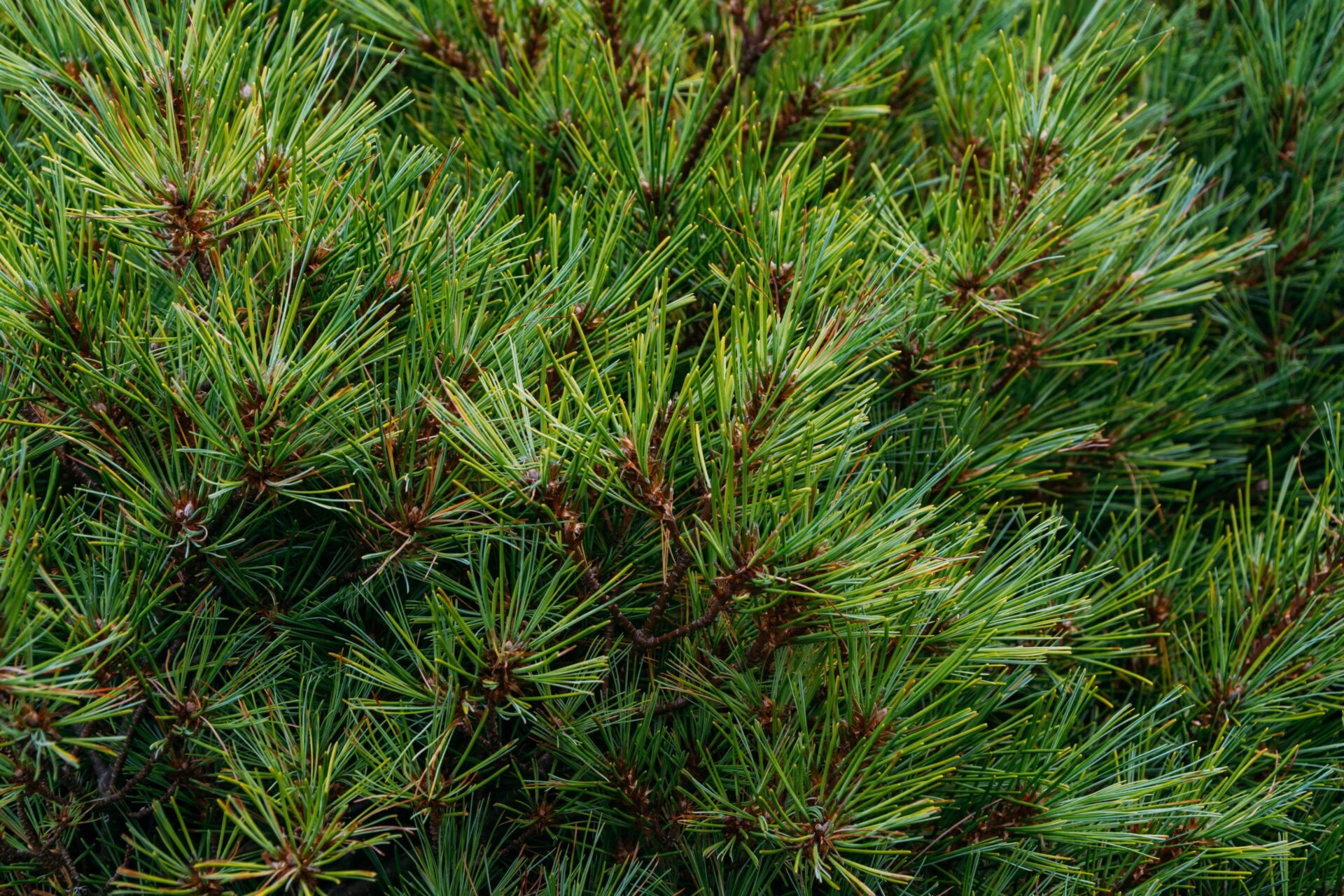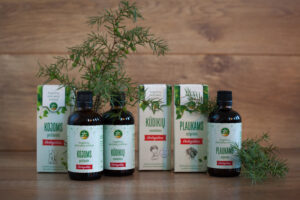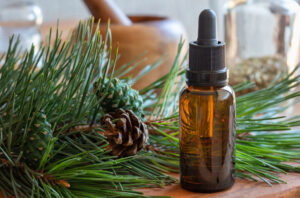Pine (Pinus sylvestris)
Plant family Pinaceae
Sinonimai
Scots pine, Norway pine
Kilmė
Scots pine is widespread in the Baltic States, Scandinavia, Germany and the USA.
Pine needles have been used medicinally for hundreds of years to alleviate nervous exhaustion and treat rheumatism, and were used by American Indians against insects. Pine oil is widely used in disinfectants, detergents, insecticides and paints, in the paper industry and in perfumery, especially for making bath salts and soaps.
Gamybos būdas
Steam distillation of conifers. Lower quality oils are also extracted from pine cones, twigs and wood chips, but these are not recommended for aromatherapy.
Up to 500 kg of fresh pine needles are needed to produce 1 kg of essential oil.
The resin, or ordinary turpentine, is obtained by pickling pine trees. This is a solution of resin in essential oil called resin turpentine.
Aliejaus pobūdis
Colourless or pale yellow liquid. The aroma is strong, dry and balsamic, with a whiff of turpentine. The scent is refreshing, cooling and energising.
Aromatic note – mid to base. The aroma lasts from two to six days.
Main ingredients
| apha-Pinene | 20.3 – 4 5.8% |
| beta-Pinene | 1.9 – 33.3% |
| sigma-3-Carene | 0.4 – 31.8% |
| beta-Phellandrene | 0.3 – 10.9% |
| Sigma-Cadinene | tr – 9.5% |
| Camphene | 1.6 – 9.4% |
| alpha-Muurolene | tr – 7.8% |
| Beta-Bisabolene | 0 – 6.3% |
| Gamma-Cadinene | tr – 5.4% |
| (+)-Limonene | 0.7 – 5.2% |
| Caryophyllene oxide | 0.0 – 4.9% |
| Bornyl acetate | 0.0 – 4.2% |
| beta-Myrcene | 2. 1 – 3.8% |
| beta-Caryophyllene | 0.7-3.8% |
| Longifolene | 0.0 – 3. 5% |
| alpha-Terpinene | 0.1 – 3. 2% |
| Terpinolene | tr – 3.0% |
| 1,8-Cineole | 0.0 – 2.9% |
| alpa-Cadinol | 0.0 – 2.7% |
| Fenchone | 0.0 – 2.1% |
| Gamma-Muurolene | 0.0 – 2.0% |
| alpha-Terpineol | 0.0 – 1.9% |
| Tricyclen | 0.4-1.8% |
| alpha-Caryophyllene | tr – 1.8% |
| (Z) -beta-Ocimene | 0.0 – 1.8% |
| Chamazulene | 0.0 – 1.7% |
| (E) – beta-Ocimene | 0.0 -1.5% |
| Germacrene D | 0.0 – 4% |
| T-Muurolol | 0.0 -1.0% |
| Sabinene | 0.0 -1.0% |
Savybės
Antimicrobial, antirheumatic, antiseptic (lung, urinary, liver), antiviral, bactericidal, balsamic, cholagogue, circulatory stimulant, deodorising, insecticidal, restorative, muscular, adrenocortical and nerve stimulant, antiparasitic.
Terapinės savybės
Pine has a refreshing and opening effect. It can be used to make massage and bath oils, and is also ideal for steam inhalation. Pine has a revitalising effect on the nervous system and can be used to treat nervous exhaustion and poor concentration.
The main effect of pine is on the respiratory tract. It is a powerful respiratory antiseptic and decongestant. It strengthens the lungs and can be used to treat bronchial infections such as bronchitis, asthma, flu, coughs and colds. Clears mucus from the chest and throat and catarrh from the sinuses.
Baths with pine essential oil relieve aches and pains after a tiring day. It can also be used in compresses or massage oils to treat rheumatism, arthritis and sprains.
Pine oil is suitable for treating scabies and lice. It is also a good deodorant – use it for foot baths, to eliminate the smell between the toes.
Aromatherapy uses
Cuts and scratches, wounds, scabies, excessive sweating, arthritis, gout, muscle aches, circulatory problems, rheumatism, respiratory problems, cystitis, colds and flu, neuralgia, fatigue, stress-related disorders.
Psichologinis profilis
Scots pine essential oil is one of the safest and gentlest aromatherapy products available. The aroma is calming and relaxing. It is not for nothing that we are so attracted to the harmonious and clean environment of the pine forests, which helps us to forget fatigue, stress and regain our strength. Pine essential oil has the same properties! This fragrance is particularly suitable for people who work a lot and are stressed.
Pine is appropriate if you are dealing with strong feelings of guilt. You may have been abused and punished as a child for a rebellious spirit or misbehaviour. Guilt can come from a very religious background, believing in divine punishment for your sins. Such experiences can lead to a tendency to fear pleasure and deny feelings, which inevitably leads to inner conflict. This can lead to a tendency to be harsh and self-punishing, and on a physical level to tension and chest tightness. Using pine oil will help to break through all kinds of firmness and allow you to reconnect with your sensitivity, giving yourself more pleasure and happiness in life.
Ideal for use with:
Bergamot, Cedarwood, Cypress, Eucalyptus, Eucalyptus, Frankincense, Juniper, Lavender, Lemon, Rosemary, Tea Tree essential oils.
Mūsų saugos patarimai
Due to its alpha-pinene and sigma-3-carene content, we recommend avoiding oxidation of Scots pine oil by storing it in a dark, airtight container in the fridge.
Įspėjimai
It is generally considered to be non-irritant, although there are many reports indicating that pine essence is a sensitising agent. Old and oxidised oils can cause irritation and sensitisation problems. Oil should be avoided by those with sensitive skin. Always use a small amount, around 1%.
Other species
Other pine species from which essential oils are produced are the dwarf pine (Pinus pumilio or Pinus mugo) and the longleaf pine (Pinus palustris). Dwarf pine oil should not be used in aromatherapy as it irritates and sensitises the skin. Longleaf pine is the most common source of turpentine and is often used in the USA. It has very similar therapeutic properties to Scots pine oil.
References
1. C. Wildwood “The Encyclopedia of Aromatherapy”, Vermont, Healing Arts Press, 1996
2. R. Tisserand, R. Young, E. M Williamson “Essential Oil Safety. A Guide for Health Care Professionals”, Churchill Livingstone ELSEVIER, 2014
3. S. Curtis “Essential Oils”, AURUM, London, 1996
4. R. Balz “The Healing Power of Essential Oils”, LOTUS LIGHT SHANGRI-LA, Twin Lakes, 1996
5. Л.ГДудченко, Г.П.Потебня, Н.А.Кривенко «Ароматерапия и аромамасаж», «Максимум», Киев, 1999





